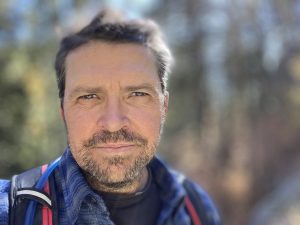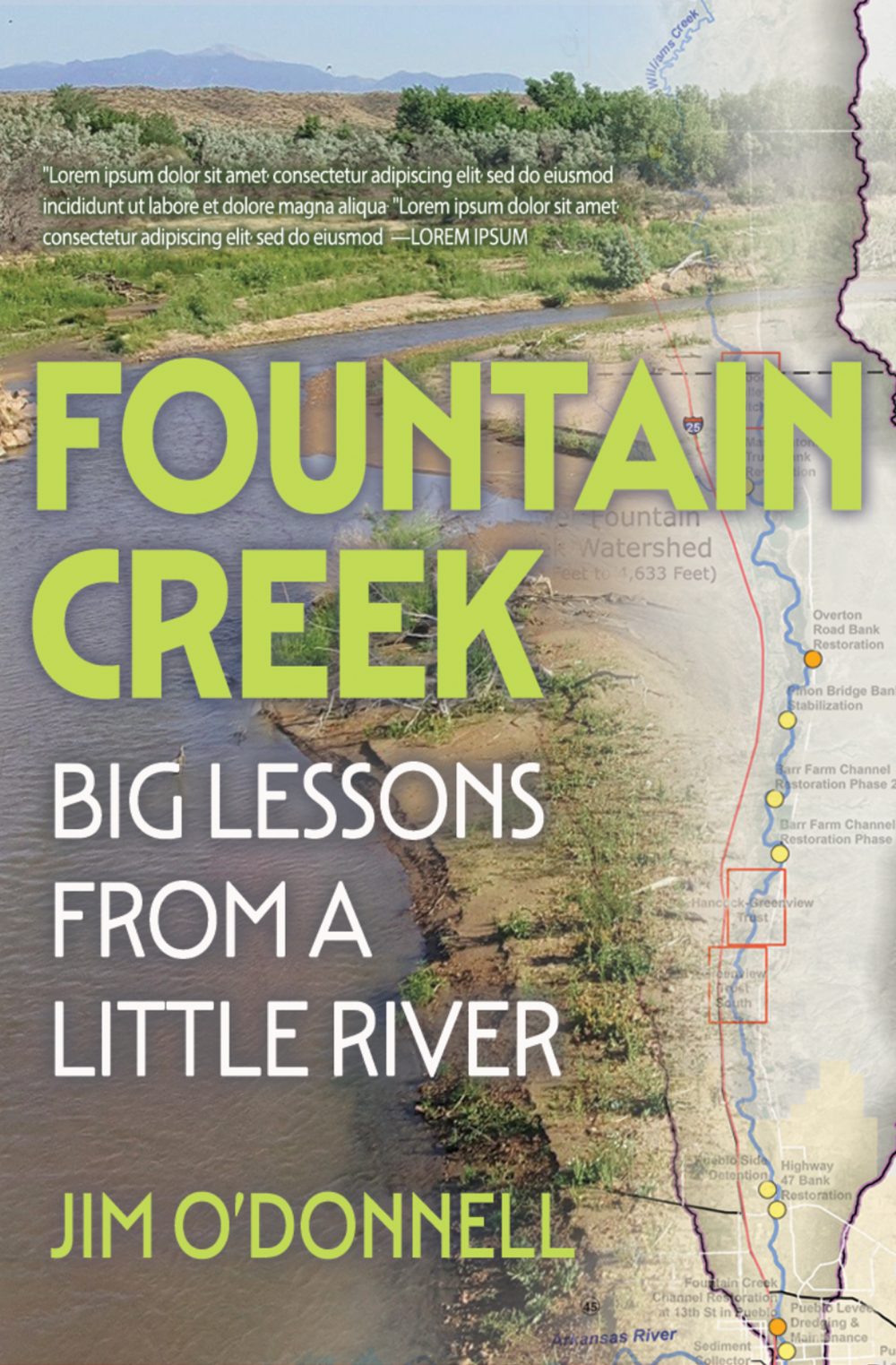The first comprehensive book ever written about Colorado’s beleaguered Fountain Creek, what we can learn and where we go from here.
For Water Education Colorado readers Torrey House Press is offering a discount for preorders made prior to October 20, 2024. Use discount code PUBLICLANDS at checkout. Preorder Fountain Creek here: https://www.torreyhouse.org/fountain-creek
Three geese scooted the creek then veered towards a mass of cattails. A coyote slipped into the tamarisk, reappeared upstream, then vanished. Deer prints tracked feeble smears of snow edging the ice. I came to the bridge just after dawn. Along the creek the forest was all faded yellows and shades of gray. I walked up from Fountain Creek trailing the ghost-whinny of a woodpecker. The sky, a cold, indifferent blue, pushed to the rim of the mountains where gloomy clouds crowded the peaks and ridges.
There was a place along that section of Colorado’s Fountain Creek where a beaver constructed a dam. The beaver’s pond was long, skinny, deep, snaking from the dam through an elven copse of elms, willows, and sheltering cottonwoods. There, the aquatic rodent had cleared dozens of trees, creating a wide and open meadow filled with water, a rich, wetland ecosystem in the middle of the forest.
The path I followed to reach the beaver dam runs for several miles along Fountain Creek just south of the city of Colorado Springs.
We call the Fountain a “creek” because once-upon-a-time it actually was a creek; a thirsty, ephemeral waterway, tributary to the Arkansas River, prone to occasional dramatic floods. Today, the Fountain runs full and swift the entire year.
The Fountain trickles from snows blanketing the slopes of the 14,115-foot high mountain most Americans know as Pike’s Peak. The original people of the region, the Tabeguache Ute – Nuuchiu in their own language – know the peak as Tavá Kaa-vi, “Sun Mountain” and the waters birthed from Tavá flow seventy-four and a half miles to its confluence with the Arkansas River at 4,695 feet in my hometown of Pueblo, Colorado.
Fountain Creek is one of the most human-dominated water systems in the American West – and that’s saying something.
Over the years, the Fountain has been dammed, diverted, poisoned, re-routed, mapped, named, channelized, filled with physical and human debris, reduced, augmented, confused, litigated, studied, stolen, replaced, piped, known, unknown, forgotten, remembered, misunderstood, blamed, monitored, sampled, screened, broken and very nearly tamed. More than anything else, humans have altered the very nature of the Fountain, pumping water from Colorado’s western slope into the Fountain’s watershed, making what was once an occasional creek into a full-time river. Given the number of “real” rivers drying up across the American West, the creation of a “new” river is more than a bit mind-bending.
Fountain Creek is the posterchild of the Anthropocene.
I grew up near the Fountain in Pueblo. As kids and later in high school we spend a lot of time along the Fountain, exploring, playing, and causing trouble. So, the creek has been imprinted on my mind as long as I can remember.
Once upon a time, I had the idea to spend a year or more retracing the 1806-1807 trek of Lt. Zebulon Pike from St. Louis across the Great Plains, into Colorado, New Mexico and ultimately to Chihuahua in Mexico. Pike’s colonial expedition has fascinated me since I was a teenager and I had hoped to have a book ready for publication for the 200th anniversary of the expedition in 2006.
Life intervened however. Soon after completing a 1500 mile walk across Finland, my inquisitive, beautiful daughter appeared. It was not too long before another baby popped out, this one a brilliant curly headed boy. Needless to say, all my plans went right out the window. Later, as the COVID pandemic waned and my children graduated high school, the idea to retrace Pike’s route returned. I picked up Pike’s journals and began to re-read them. When I returned to the part where Pike and his crew camped at the confluence of the Fountain and Arkansas River (then attempted to climb The Peak) I read and re-read his one brief mention of the Fountain and a light bulb went on.
The Fountain was the perfect combination of my fascination with history and watersheds. And even better, it was a story that was untold. I searched in vain to find any books about Fountain Creek. And there are none. The beleaguered Fountain Creek was itself a story waiting to be told, a story that helps us see how we might re-imagine our relationships with our waterways and how we might manage Colorado and Western waters into the future.
There was another driver for me. As the cement and asphalt urban sprawl eats up the Front Range and climate change alters Colorado’s hydrology, I felt an obligation to bear witness to these changes, to note down what the Fountain Creek watershed looks and feels like today in the early 2020s. I know as a former archaeologist and passionate student of history that such accounts will prove priceless to researchers one hundred or even five hundred years from now.
One of the key messages of this book is that our present day circumstances and struggles are not always inevitable. It didn’t have to be this way. We created the current challenges with our water ways through our choices as a society. The way in which we live today and the way we manage our waters results from a series of choices that were made in the past. And many of those choices were not smart. Thus, we find ourselves in a situation where waterways like Fountain Creek have countless problems and we struggle to deal with those problems because of all the poor choices we made in the past.
How can we do better?
We have the opportunity to make better choices for the future. This book encourages us all to rethink how we approach managing our waters. We create the future through our present day choices and the future can be whatever we want it to be.
Dream big and dream disruptive.
 Jim O’Donnell was born and raised in Pueblo, Colorado. A fifth generation Coloradoan, O’Donnell worked many years as an archaeologist before focusing his eye on public lands protection and watershed restoration. He is the father of three children and writes from Taos, New Mexico where he lives with his wife Rasa. He is the author of numerous short works of fiction, countless journalistic articles and the non-fiction work “Notes for the Aurora Society: 1500 miles on Foot Across Finland.” Learn more at: www.aroundtheworldineightyyears.com
Jim O’Donnell was born and raised in Pueblo, Colorado. A fifth generation Coloradoan, O’Donnell worked many years as an archaeologist before focusing his eye on public lands protection and watershed restoration. He is the father of three children and writes from Taos, New Mexico where he lives with his wife Rasa. He is the author of numerous short works of fiction, countless journalistic articles and the non-fiction work “Notes for the Aurora Society: 1500 miles on Foot Across Finland.” Learn more at: www.aroundtheworldineightyyears.com


 Print
Print